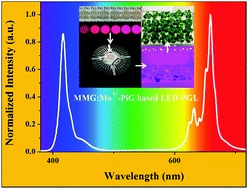Ultrastable red-emitting phosphor-in-glass for superior high-power artificial plant growth LEDs†
Abstract
Ultrastable red-emitting phosphor-in-glass (PiG) consisting of 3.5MgO·0.5MgF2·GeO2:Mn4+ (MMG:Mn4+) phosphor in a glass matrix was prepared for superior artificial plant growth LEDs (PGLs). These obtained PiG plates show a thermal conductivity of 1.671 W m−1 K−1 and an external quantum efficiency of 27.5%, which provides the strong foundation for the application in high-power artificial plant growth LEDs (PGLs). Furthermore, a proof-of-concept PGL using 36 pieces of the title PiG plate and 420 nm-blue LED chip was fabricated. The combination of ∼420 nm from chip and the ∼659 nm chip from the MMG:Mn4+ phosphor provide a well-matched spectrum with the absorption bands of photosynthetic pigments and the phytochrome (PR and PFR) of most green plants. As expected, the as-fabricated PGL-treated milk-Chinese cabbage cultured in the indoor plant factory showed that after 15 day-irradiation, the plant biomass was nearly 48.9% greater in treated sample than those cultured using the general R-B LED lamps. Further analysis also demonstrated that promotive effect can also be obtained in the level of ascorbic acid, soluble protein, soluble sugar and total chlorophyll. The PiG strategy presented in this paper afforded superior high-power artificial plant growth LEDs, which are crucial in the application of ecological agriculture.



 Please wait while we load your content...
Please wait while we load your content...